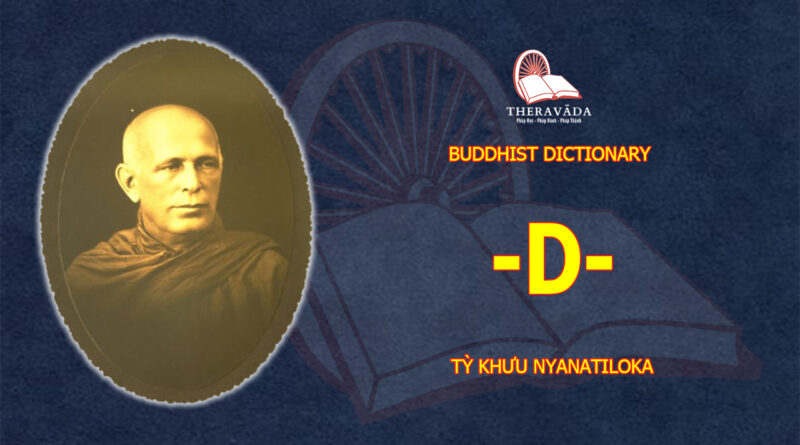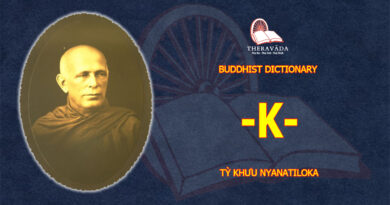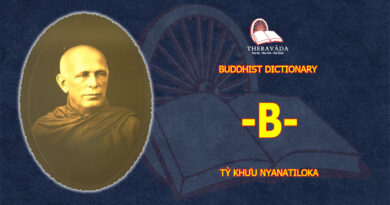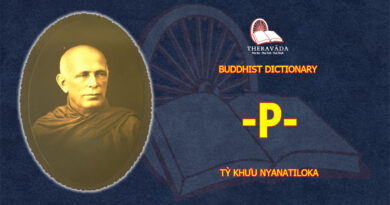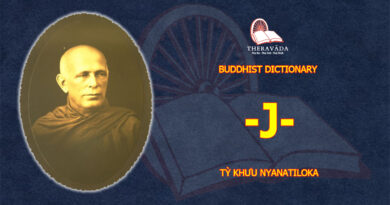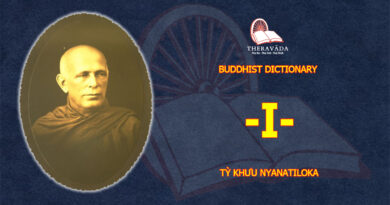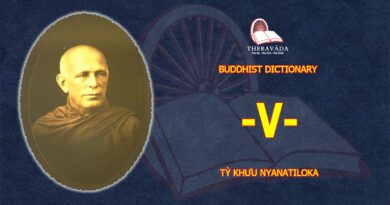BUDDHIST DICTIONARY
-D-
dāna: ‘almsgiving’, liberality, offering. “He who gives alms, bestows a fourfold blessing: he helps to long life, good appearance, happiness and strength. Therefore long life, good appearance, happiness and strength will be his share, whether amongst heavenly beings or amongst men” (A. IV, 57).
“Five blessings accrue to the giver of alms: the affection of many, noble association, good reputation, self-confidence, and heavenly rebirth” (see A. V, 34). Seven further blessings are given in A. VII, 54.
Liberality, especially the offering of robes, food, etc., to the monks, is highly praised in all Buddhist countries of Southern Asia as a fundamental virtue and as a means to suppress man’s inborn greed and egoism. But, as in any other good or bad action, so also in offering gifts, it is the noble intention and volition that really counts as the action, not the mere outward deed.
Almsgiving or liberality (dāna), constitutes the first. kind of meritorious activity, the two others being morality (sīla, q.v.) and mental development (bhāvanā); s. puñña-kiriya-vatthu. Liberality (cāga) forms one of the 10 recollections (anussati, q.v.) and almsgiving one of the 10 perfections (s. pāramī).
dasa-(Tathāgata-) bala: ‘the ten powers (of a Perfect One); or, he who Possesses the 10 P.’, i.e. the Buddha. About him it is said (e.g., M. 12.; A. X, 21):
There, o monks, the Perfect One understands according to reality the possible as possible, and the impossible as impossible … the result of past, present and future actions … the path leading to the welfare of all … the world with its many different elements … the different inclinations in beings … the lower and higher faculties in beings … the defilement, purity and rising with regard to the absorptions, deliverances, concentration and attainments … remembering many former rebirths … perceiving with the divine eye how beings vanish and reappear again according to their actions (kamma) … gaining, through extinction of all taints, possession of ‘deliverance of mind’ and ‘deliverance through wisdom’ ….”
dasaka-kalāpa: s. rūpa-kalāpa.
dasa-pāramī: s. pāramī.
dasa-puñña-kiriya-vatthu: s. puñña-kiriya-vatthu.
death: maraṇa (q.v.) – Contemplation of °: maraṇānussati (q.v.) – As divine messenger: deva-dūta (q.v.).
death-consciousness: cuti-citta, is one of the 14 functions of consciousness (viññāṇa-kicca, q.v.).
deathlessness: amata (q.v.).
death-proximate kamma: maraṇāsaññā-kamma; s.kamma.
deciding function (of consciousness): s. viññāṇa-kicca.
decline (in morality, wisdom, etc.): s. hāna-bhāgiya-sīla. – Liable to °, parihāna-dhamma (q.v.).
defilements: s. kilesa, upakkilesa . -10 d. of insight: vipassanūpakkilesa, s. visuddhi VI. – Round of d., s. vatta (1).
deliverance: s. vimutti, vimokkha. – The 8 kinds of deliverance (or liberation), s. vimokkha. – D. of mind, d. through voidness, boundless d. etc., s. ceto-vimutti. – Desire for d., s. visuddhi (VI, 6). – D.through wisdom; paññā-vimutti (q.v.). – 3 doors of d. (or gateways of liberation) s. visuddhi (VI, 8).
deluded consciousness: s. Tab. I. 32, 33.
deluded-natured: moha-carita; s. carita.
delusion: s. moha, avijjā.
demons’ realm: asura-nikāya; s. apāya.
departed, the spirits of the: peta (q.v.).
dependent origination: paṭiccasamuppāda (q.v.).
derived corporeality: upādā-rūpa (q.v.); further s. khandha (I. B.).
desanā: ‘exposition’ of the doctrine, may be either an exposition true in the highest sense (paramattha-desanā); or it may not be true in the highest, but only in the conventional sense (vohāra-desanā). See paramattha.
desire for deliverance: s. visuddhi (VI, 6).
desireless deliverance: s. vimokkha (1).
desirelessness, contemplation on: s. vipassanā (12).
destiny, evil views with fixed d.: niyata-micchā-diṭṭhi (q.v.). Men with fixed d.: niyata-puggala (q.v.). See gati.
destruction: overcoming, or liberation from, evil things through their d.; samuccheda-pahāna or samuccheda-vimutti; s. pahāna.
destructivekamma: upaghāṭaka-kamma; s.kamma.
detachment: viveka (q.v.).
determination: s. adhimokkha, adhiṭṭhāna.
determining: voṭṭhapana (s. viññāṇa-kicca).
determining the reality: s. vavatthāna.
deva (lit: the Radiant Ones; related to Lat. deus): heavenly beings, deities, celestials, are beings who live in happy worlds, and who, as a rule, are invisible to the human eye. They are subject, however, just like all human and other beings, to ever-repeated rebirth, old age and death, and thus are not freed from the cycle of existence and from misery. There are many classes of heavenly beings.
- The 6 classes of heavenly beings of the sensuous sphere (kāmāvacara or kāma-loka; s. avacara loka), are Cātumahārājika-deva, Tāvatiṃsa, Yāma, Tusita (s. Bodhisatta), Nimmāna-rati, Paranimmita-vasavatti. Cf. anussati. (6).
- The heavenly beings of the fine-material sphere (rūpāvacara or rūpaloka) are:
- Brahma-pārisajja, Brahma-purohita, Mahā-brahmāno (s. brahma-kāyika-deva). Amongst these 3 classes will be reborn those with a weak, medium or full experience of the 1st absorption (jhāna, q.v.).
- Parittābha, Appamānābha, Ābhassara. Here will be reborn those with experience of the 2nd absorption.
- Paritta-subha, Appamāna-subha, Subha-kiṇṇa (or kiṇha). Here will be reborn those with experience of the 3rd absorption.
- Vehapphala, Asañña-satta (q.v.), Suddhāvāsa (q.v.; further s. Anāgāmi). Amongst the first 2 classes will be reborn those with experience of the 4th absorption, but amongst the 3rd class only Anāgāmis(q.v.).
III. The 4 grades of heavenly beings of the immaterial sphere (arūpāvacara or arūpa-loka) are: the heavenly beings of the sphere of unbounded space (ākāsānañcāyatanūpaga-devā), of unbounded consciousness (viññāṇañcāyatanūpaga-deva), of nothingness (ākiñcaññāyatanūpaga devā), of neither-perception-nor- non-perception (nevasaññā-nāsaññāyatanūpaga-devā). Here will be reborn those with experience of the 4 immaterial spheres (arūpāyatana; s. jhāna 5-8).
See Gods and the Universe by Francis Story (WHEEL 180/181).
deva-dūta: ‘divine messengers’, is a symbolic name for old age, disease and death, since these three things remind man of his future and rouse him to earnest striving. In A. III, 35, it is said:
“Did you, o man, never see in the world a man or a woman eighty, ninety or a hundred years old, frail, crooked as a gable-roof, bent down, resting on crutches, with tottering steps, infirm, youth long since fled, with broken teeth, grey and scanty hair, or baldheaded, wrinkled, with blotched limbs? And did it never occur to you that you also are subject to old age, that you also cannot escape it?
“Did you never see in the world a man or a woman, who being sick, afflicted and grievously ill, and wallowing in their own filth, was lifted up by some people, and put down by others? And did it never occur to you that you also are subject to disease, that you also cannot escape it?
“Did you never see in the world the corpse of a man or a woman, one or two or three days after death, swollen up, blue-black in colour, and full of corruption? And did it never occur to you that you also are subject to death, that you also cannot escape it?” – See M. 130.
devatānussati: ‘recollection of the heavenly beings’; s. anussati.
development (mental): bhāvanā (q.v.). – Effort to develop, s. padhāna. – Wisdom based on d. s. paññā. – Gradual d. of the Eightfold Path in the ‘progress of the disciple’ (q.v.).
deviation: (from morality and understanding): vipatti (q.v.).
devotee: upāsaka (q.v.) .
dhamma: lit. the ‘bearer’, constitution (or nature of a thing), norm, law (jus), doctrine; justice, righteousness; quality; thing, object of mind (s. āyatana) ‘phenomenon’. In all these meanings the word‘dhamma‘ is to be met with in the texts. The Com. to D. instances 4 applications of this term guṇa (quality, virtue), desanā (instruction), pariyatti (text), nijjīvatā (soullessness, e.g. “all dhammā, phenomena, are impersonal,” etc.). The Com. to Dhs. has hetu (condition) instead of desanā. Thus, the analytical knowledge of the law (s. paṭisambhidā) is explained in Vis.M. XIV. and in Vibh. as hetumhi ñāṇa,knowledge of the conditions.
The Dhamma, as the liberating law discovered and proclaimed by the Buddha, is summed up in the 4 Noble Truths (s. sacca). It forms one of the 3 Gems (ti-ratana, q.v.) and one of the 10 recollections(anussati q.v.).
Dhamma, as object of mind (dhammāyatana, s. āyatana) may be anything past, present or future, corporeal or mental, conditioned or not (cf. saṅkhāra, 4), real or imaginary.
dhamma-cakka: The ‘Wheel (realm) of the Law’, is a name for the doctrine ‘set rolling’ (established) by the Buddha, i.e. the 4 Noble Truths (sacca, q.v.).
“The Perfect One, o monks, the Holy One, fully Enlightened One, in the Deer Park at Isipatana near Benares, has set rolling (established) the unsurpassed Wheel (realm) of the Law” (M. 141). Cf. cakka.
dhamma-desanā: ‘exposition of the Doctrine (law)’; s. desanā.
dhamma-dhātu: mind-object-element (s. dhātu).
dhammānupassanā: ‘contemplation of the mind-objects’ is the last of the 4 foundations of mindfulness (Satipaṭṭhāna, q.v.)
dhammānusārī: the ‘Dhamma–devotee’, is one of the 7 noble disciples (ariya-puggala, q.v.).
dhammānussati: ‘recollection of the Law’, is one of the 10 recollections (anussati, q.v.).
dhamma-paṭisambhidā: the ‘analytical knowledge of the law, is one of the 4 kinds of analytical knowledge (paṭisambhidā, q.v.).
dhamma-ṭṭhiti-ñāṇa: ‘knowledge of the fixity of law, is a name for that ‘insight which is leading up’ to the entrance into one of the 4 supermundane paths (vuṭṭhāna-gāminī-vipassanā, q.v.). In the Susima Sutta (S. XII, 70) this (ascending) insight is called the ‘knowledge of the fixity of the law’, namely: “At first, Susima, there exists the knowledge of the fixity of the law, and later the knowledge of Nibbāna.” (See Vis.M. XXI.)
dhamma-vicaya-sambojjhaṅga: ‘investigation of the law as factor of enlightenment’, is one of the 7 factors of enlightenment (bojjhaṅga, q.v.).
dhammāyatana: ‘mind-object as base’ (āyatana, q.v.).
dhana : ‘treasures’, a term for the following 7 qualities: faith, morality, moral shame, moral dread, learning, liberality and wisdom. Cf. A. VII, 5, 6.
See ‘Treasures of the Noble’, by Soma Thera (BODHI LEAVES B. 27, BPS).
dhātu: ‘elements’, are the ultimate constituents of a whole.
(1) The 4 physical elements (dhātu or Mahā-bhūta), popularly called earth, water, fire and wind, are to be understood as the primary qualities of matter. They are named in Pāḷi: paṭhavī-dhātu, āpo-dhātu, tejo-dhātu, and vāyo-dhātu. In Vis.M. XI, 2 the four elements are defined thus: “Whatever is characterized by hardness (thaddha-lakkkhaṇa) is the earth or solid-element; by cohesion (ābandhana ) or fluidity, the water-element; by heating (paripācana), the fire or heat-element; by strengthening or supporting (vitthambhana), the wind or motion-element. All four are present in every material object, though in varying degrees of strength. If, for instance, the earth element predominates, the material object is called ‘solid’, etc. – For the analysis of the 4 elements, s. dhātu–vavatthāna.
(II) The 18 physical and mental elements that constitute the conditions or foundations of the process of perception, are:
- visual organ (eye) 9. gustative object
- auditory organ (ear) 10. body-impression
- olfactory organ (nose) 11. eye-consciousness
- gustatory organ (tongue) 12. ear-consciousness
- tactile organ (body) 13. nose-consciousness
- visible object 14. tongue-consciousness
- sound or audible object 15. body-consciousness
- odour or olfactive object
- mind-element 17. mind-object
(mano-dhātu) (dhamma-dhātu)
- mind-consciousness-element
(mano-viññāṇa-dhātu)
1-10 are physical; 11-16 and 18 are mental; 17 may be either physical or mental. – 16 performs the function of advertence (āvajjana) towards the object at the inception of a process of sensuous consciousness; it further performs the function of receiving (sampaṭicchana) the sensuous object. 18 performs, e.g., the function of investigation (santīraṇa), determining (voṭṭhapana) and registering (tadārammaṇa) – (for its other functions, s. Table I). For the 14 functions of consciousness, s. viññāṇa-kicca.
Cf. M. 115; S. XIV and especially Vibh. II (Guide p. 28f), Vis.M. XV, 17ff.
Of the many further groupings of elements (enumerated in M. 115), the best known is that of the 3 world-elements: the sensuous world (kāma-dhātu), the fine-material world (rūpa-dhātu), the immaterial world (arūpa-dhātu); further the sixfold group: the solid, liquid, heat, motion, space, consciousness (paṭhavī, āpo, tejo, vāyo, ākāsa, viññāṇa; s. above I), described in M. 140; see also M. 112.
dhātu-vavatthāna: ‘analysis (or determining) of the 4 elements’, is described in Vis.M. XI, 2, as the last of the 40 mental exercises (s. bhāvanā). In a condensed form this exercise is handed down in D. 22 and M. 10 (s. Satipaṭṭhāna), but in detail explained in M. 28, 62, 140. The simile of the butcher in M. 10 (“Just, o monks, as a skilled butcher or butcher’s apprentice, after having slaughtered a cow and divided it into separate portions, should sit down at the junction of four highroads; just so does the disciple contemplate this body with regard to the elements”) is thus explained in Vis.M. XI.: “To the butcher, who rears the cow, brings it to the slaughter-house, ties it, puts it there, slaughters it, or looks at the slaughtered and dead cow, the idea ‘cow’ does not disappear as long as he has not yet cut the body open and taken it to pieces. As soon, however, as he sits down, after having cut it open and taken it to pieces, the idea ‘cow’ disappears to him, and the idea ‘meat’ arises. And he does not think: ‘A cow do I sell, or ‘A cow do they buy.’ Just so, when the monk formerly was still an ignorant worldling, layman or a homeless one, the ideas ‘living being’ or ‘man’ or ‘individual’ had not yet disappeared as long as he had not taken this body, whatever position or direction it had, to pieces and analysed it piece by piece. As soon, however, as he analysed this body into its elements, the idea ‘living being’ disappeared to him, and his mind became established in the contemplation of the elements.” – (App.).
dhutaṅga: (lit. ‘means of shaking off (the defilements)’); ‘means of purification’, ascetic or austere practices. These are strict observances recommended by the Buddha to monks as a help to cultivate contentedness, renunciation, energy and the like. One or more of them may be observed for a shorter or longer period of time.
“The monk training himself in morality should take upon himself the means of purification, in order to gain those virtues through which the purity of morality will become accomplished, to wit: fewness of needs, contentedness, austerity, detachment, energy, moderation, etc.” (Vis.M. II).
Vis.M. II describes 13 dhutaṅgas, consisting in the vows of
- wearing patched-up robes: paṃsukūlikaṅga,
- wearing only three robes: tecīvarikaṅga,
- going for alms: piṇḍapātikaṅga,
- not omitting any house whilst going for alms: sapadānikaṅga,
- eating at one sitting: ekāsanikaṅga,
- eating only from the alms-bowl: pattapiṇḍikaṅga,
- refusing all further food: khalu-pacchā-bhattikaṅga,
- living in the forest: āraññikaṅga,
- living under a tree: rukkha-mūlikaṅga,
- living in the open air: abbhokāsikaṅga,
- living in a cemetery: susānikaṅga,
- being satisfied with whatever dwelling: yathā-santhatikaṅga,
- sleeping in the sitting position (and never lying down): nesajjikaṅga.
These 13 exercises are all, without exception, mentioned in the old Sutta texts (e.g. M. 5, 113; A.V., 181-90), but never together in one and the same place.
“Without doubt, o monks, it is a great advantage to live in the forest as a hermit, to collect one’s alms, to make one’s robes from picked-up rags, to be satisfied with three robes” (A.I, 30).
The vow, e.g. of No. 1, is taken in the words: “I reject robes offered to me by householders,” or “I take upon myself the vow of wearing only robes made from picked-up rags.” Some of the exercises may also be observed by the lay-adherent.
Here it may be mentioned that each newly ordained monk, immediately after his being admitted to the Order, is advised to be satisfied with whatever robes, alms-food, dwelling and medicine he gets: “The life of the monks depends on the collected alms as food … on the root of a tree as dwelling … on robes made from patched-up rags … on stale cow’s urine as medicine. May you train yourself therein all your life.”
Since the moral quality of any action depends entirely upon the accompanying intention and volition, this is also the case with these ascetic practices, as is expressly stated in Vis.M. Thus the mere external performance is not the real exercise, as it is said (Pug. 275-84): “Some one might be going for alms; etc. out of stupidity and foolishness – or with evil intention and filled with desires – or out of insanity and mental derangement – or because such practice had been praised by the Noble Ones….” These exercises are, however properly observed “if they are taken up only for the sake of frugality, of contentedness, of purity, etc.”(App.)
On dhutaṅga practice in modern Thailand, see With Robes and Bowl, by Bhikkhu Khantipālo (WHEEL 82/83).
dibba-cakkhu: the ‘divine eye’, is one of the 6 higher powers (abhiññā, q.v.), and one of the three kinds of knowledge (tevijjā, q.v.).
dibba-loka: heavenly world; s. deva.
dibba-sota: the ‘divine ear’, is one of the 6 higher powers (abhiññā, q.v.).
dibba-vihāra: s. vihāra.
disappearance: vigata-paccaya, is one of the 24 conditions (paccaya, q.v.) . disciplinary code: s. Pātimokkha.
discursive thinking: vicāra; s. vitakka-vicāra.
disease: one of the ‘divine messengers’ (deva-dūta, q.v.).
disinterestedness: (regarding the whole world): s. sabbaloke anabhiratisaññā.
dispensation: s.sāsana.
dissociation: vippayutta-paccaya, is one of the 24 conditions (paccaya, q.v.) .
dissolution, contemplation of: khayānupassanā, is one of the 18 chief kinds of insight (vipassanā, q.v.).
diṭṭha-dhamma-vedanīya-kamma:kamma bearing fruit in this present life; s.kamma.
diṭṭhi (lit. ‘sight’; √dis to see): view, belief, speculative opinion, insight. If not qualified by sammā, ‘right’, it mostly refers to wrong and evil view or opinion, and only in a few instances to right view, understanding or insight (e.g. diṭṭhi-ppatta, q.v.; diṭṭhi-visuddhi, purification of insight; diṭṭhi-sampanna, possessed of insight).
Wrong or evil views (diṭṭhi or micchā-diṭṭhi) are declared as utterly rejectable for being a source of wrong and evil aspirations and conduct, and liable at times to lead man to the deepest abysses of depravity, as it is said in A. I, 22:
“No other thing than evil views do I know, o monks, whereby to such an extent the unwholesome things not yet arisen arise, and the unwholesome things already arisen are brought to growth and fullness. No other thing than evil views do I know, whereby to such an extent the wholesome things not yet arisen are hindered in their arising, and the wholesome things already arisen disappear. No other thing than evil views do I know, whereby to such an extent human beings at the dissolution of the body, at death, are passing to a way of suffering, into a world of woe, into hell.” Further in A. I, 23: “Whatever a man filled with evil views performs or undertakes, or whatever he possesses of will, aspiration, longing and tendencies, all these things lead him to an undesirable, unpleasant and disagreeable state, to woe and suffering.”
From the Abhidhamma (Dhs) it may be inferred that evil views, whenever they arise, are associated with greed (s. Tab. I. 22, 23, 26, 27).
Numerous speculative opinions and theories, which at all times have influenced and still are influencing mankind, are quoted in the Sutta-texts. Amongst them, however, the wrong view which everywhere, and at all times, has most misled and deluded mankind is the personality-belief, the ego-illusion. This personality-belief (sakkāya-diṭṭhi), or ego-illusion (atta-diṭṭhi), is of 2 kinds: eternity-belief and annihilation-belief.
Eternity-belief (sassata-diṭṭhi) is the belief in the existence of a persisting ego-entity, soul or personality, existing independently of those physical and mental processes that constitute life and continuing even after death.
Annihilation-belief (uccheda-diṭṭhi), on the other hand, is the belief in the existence of an ego-entity or personality as being more or less identical with those physical and mental processes, and which therefore, at the dissolution at death, will come to be annihilated. – For the 20 kinds of personality-belief, see sakkāya-diṭṭhi.
Now, the Buddha neither teaches a personality which will continue after death, nor does he teach a personality which will be annihilated at death, but he shows us that ‘personality’, ‘ego’, ‘individual’, ‘man’, etc., are nothing but mere conventional designations (vohāra-vacana) and that in the ultimate sense (s. paramattha-sacca) there is only this self-consuming process of physical and mental phenomena which continually arise and again disappear immediately. – For further details, s. anattā, khandha, paṭiccasamuppāda.
“The Perfect One is free from any theory (diṭṭhigata), for the Perfect One has seen what corporeality is, and how it arises and passes away. He has seen what feeling … perception … mental formations … consciousness are, and how they arise and pass away. Therefore I say that the Perfect One has won complete deliverance through the extinction, fading away, disappearance, rejection and casting out of all imaginings and conjectures, of all inclination to the ‘vain-glory of ‘I’ and ‘mine.” (M. 72).
The rejection of speculative views and theories is a prominent feature in a chapter of the Sutta Nipāta, the Aṭṭhaka Vagga.
The so-called ‘evil views with fixed destiny’ (niyata-micchādiṭṭhi) constituting the last of the 10 unwholesome courses of action (kammapatha, q.v.), are the following three: (1) the fatalistic ‘view of the uncausedness’ of existence (ahetukadiṭṭhi), (2) the view of the inefficacy of action’ (akiriyadiṭṭhi), (3) nihilism (natthikadiṭṭhi).
(1) was taught by Makkhaligosāla, a contemporary of the Buddha who denied every cause for the corruptness and purity of beings, and asserted that everything is minutely predestined by fate.
(2) was taught by Pūraṇakassapa, another contemporary of the Buddha who denied every kammical effect of good and bad actions: “To him who kills, steals, robs, etc., nothing bad will happen. For generosity, self-restraint and truthfulness, etc. no reward is to be expected.”
(3) was taught by Ajitakesakambala, a third contemporary of the Buddha who asserted that any belief in good action and its reward is a mere delusion, that after death no further life would follow, that man at death would become dissolved into the elements, etc.
For further details about these 3 views, s. D. 2, M. 60; commentarial exposition in WHEEL 98/99, P. 23.
Frequently mentioned are also the 10 antinomies (antagāhikā micchādiṭṭhi): ‘Finite is the world’ or ‘infinite is the world’ … ‘body and soul are identical’ or ‘body and soul are different’ (e.g. M. 63).
In the Brahmajāla Sutta .(D.1), 62 false views are classified and described, comprising all conceivable wrong views and speculations about man and world.
See The All-Embracing Net of Views (Brahmajāla Sutta ), tr. with Com. by Bhikkhu Bodhi (BPS).
Further s. D. 15, 23, 24, 28; M. 11, 12, 25, 60, 63, 72, 76, 101, 102, 110; A. II, 16; X, 93; S. XXI, XXIV; Pts.M. Diṭṭhikathā,. etc.
Wrong views (diṭṭhi) are one of the proclivities (s. anusaya), cankers (s. āsava), clingings (s. upādāna), one of the three modes of perversions (s. vipallāsa). Unwholesome consciousness (akusalacitta), rooted in greed, may be either with or without wrong views (diṭṭhigata-sampayutta or vippayutta); s. Dhs.; Tab I.
On right view (sammā-diṭṭhi), s. magga and M. 9 (Trans. with Com. in ‘R. Und.’).
diṭṭhi-nissita-sīla: ‘morality based on wrong views’; s. nissaya.
diṭṭhi-ppatta: the ‘vision attainer’, is one of the 7 Noble Persons (ariya-puggala, q.v.).
diṭṭhi-vipallāsa: ‘perversion of views’; s. vipallāsa.
diṭṭhi-visuddhi: ‘purification of view’ is the 3rd of the 7 stages of purification (visuddhi III, q.v.).
ditth’upādāna: ‘clinging to views’, is one of the 4 kinds of clinging (upādāna, q.v.).
divine abode: s. vihāra.
divine ear and eye: s. abhiññā.
divine messengers, the 3: deva-dūta (q.v.).
doctrine of the Buddha: s. dhamma,sāsana.
dogmatic articles, the 3: titthāyatana (q.v.).
domanassa: lit. ‘sad-mindedness’, grief, i.e. mentally painful feeling (cetasika–vedanā), is one of the 5 feelings (vedanā, q.v.) and one of the 22 faculties (indriya, q.v.). According to the Abhidhamma, grief is always associated with antipathy and grudge, and therefore kammically unwholesome (akusala, q.v.) Cf. Tab. I. 30, 31.
domanassupavicāra: ‘indulging in grief’; s. manopavicāra.
doors of deliverance, the 3: vimokkha-dvāra; s. vimokkha I; visuddhi VI, 8.
dosa: ‘hatred’, anger, is one of the 3 unwholesome, roots (mūla, q.v.). – d. citta: hate consciousness; s. Tab. I (30, 31).
dosa-carita: ‘angry-or hate-natured’; s. carita.
doubt, skeptical: vicikicchā (q.v.), kaṅkhā (q.v.).
dread, moral: ottappa s. hiri–ottappa .
drinking: On the evil effects of drinking intoxicants, s. surāmeraya , etc.
dry-visioned: s. sukkha-vipassaka.
duccarita: ‘evil conduct’, is threefold: in deeds, words and thoughts. See kammapatha (I).
duggati: ‘woeful course’ (of existence); s. gati.
dukkha: (1) ‘pain’, painful feeling, which may be bodily and mental (s. vedanā).
(2) ‘Suffering’, ‘ill’. As the first of the Four Noble Truths (s. sacca) and the second of the three characteristics of existence (s. ti-lakkhaṇa), the term dukkha is not limited to painful experience as under (1), but refers to the unsatisfactory nature and the general insecurity of all conditioned phenomena which, on account of their impermanence, are all liable to suffering, and this includes also pleasurable experience. Hence ‘unsatisfactoriness’ or ‘liability to suffering’ would be more adequate renderings, if not for stylistic reasons. Hence the first truth does not deny the existence of pleasurable experience, as is sometimes wrongly assumed. This is illustrated by the following texts:
“Seeking satisfaction in the world, monks, I had pursued my way. That satisfaction in the world I found. In so far as satisfaction existed in the world, I have well perceived it by wisdom. Seeking for misery in the world, monks, I had pursued my way. That misery in the world I found. In so far as misery existed in the world, I have well perceived it by wisdom. Seeking for the escape from the world, monks, I had pursued my way. That escape from the world I found. In so far as an escape from the world existed, I have well perceived it by wisdom” (A. 111, 101).
“If there were no satisfaction to be found in the world, beings would not be attached to the world …. If there were no misery to be found in the world, beings would not be repelled by the world …. If there were no escape from the world, beings could not escape therefrom” (A. 111, 102).
See dukkhatā. For texts on the Truth of Suffering, see W. of B. and ‘Path’.
See The Three Basic Facts of Existence, II. Suffering (WHEEL 191/193).
dukkhānupassanā: s. vipassanā.
dukkhatā (abstr. noun fr. dukkha): ‘the state of suffering’, painfulness, unpleasantness, the unsatisfactoriness of existence. “There are three kinds of suffering: (1) suffering as pain (dukkha-dukkhatā), (2) the suffering inherent in the formations (saṅkhāra-dukkhatā), (3) the suffering in change (vipariṇāma-dukkhatā)” (S. XLV, 165; D. 33).
(1) is the bodily or mental feeling of pain as actual]y felt. (2) refers to the oppressive nature of all formations of existence (i.e. all conditioned phenomena), due to their continual arising and passing away; this includes also experiences associated with neutral feeling. (3) refers to bodily and mental pleasant feelings, “because they are the cause for the arising of pain when they change” (Vis.M. XIV, 34f).
dukkha-paṭipadā: ‘painful progress’; s. paṭipadā.
dvi-hetuka-paṭisandhi: s. paṭisandhi.
dwellings: Suitable d. for monks; s. senāsana. Satisfied with whatever d.; s. dhutaṅga.

